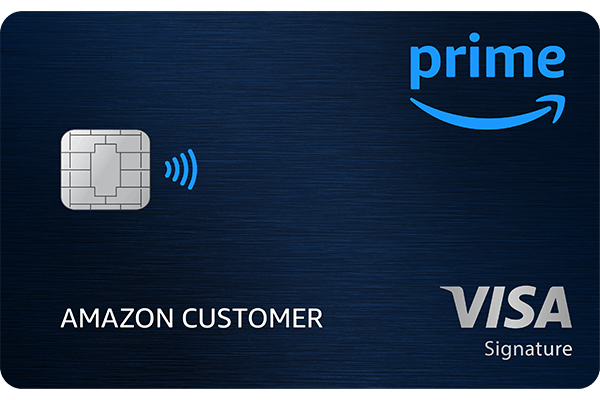Amazon Prime Visa review: Is it the ‘everything card’?

Great for Amazon Prime members

Annual Fee: $0
This content is curated by Intuit Credit Karma’s Editorial team using data from members who were approved for this card or similar cards, or who self-matched this card or similar cards. Intuit Credit Karma receives compensation from third-party advertisers, but that doesn’t affect our editors’ opinions. Our third-party advertisers don’t review, approve or endorse this content. Information about financial products not offered on Credit Karma is collected independently. Our content is accurate to the best of our knowledge when posted.
Here’s the average credit limit of members who matched their Amazon Prime Visa or similar cards.
% of members by credit limit range
The average credit limit for members who have matched with this card or similar cards is $9,254, with $500 being the most common.

Here’s the average credit score of members who matched their Amazon Prime Visa or similar cards.
% of members by credit score range
The average credit score for members who have matched with this card or similar cards is 711, with 813 being the most common. Note this is just one of the deciding factors when it comes to getting approved.

Member stats
Updated daily

27.6%
Average credit utilization (or what percent of the card’s credit limit is being used) of members who matched with this card or similar cards.

47 years
Average age of members who matched this card or similar cards.

$95,993
Average annual income of members who matched this card or similar cards. Note: Income may be estimated for some members by Credit Karma and may differ from members’ actual incomes.
Pros and cons
 Image: yes
Image: yesNo annual fee or foreign transaction fees
 Image: yes
Image: yes5% back on Amazon.com and Whole Foods purchases
 Image: yes
Image: yesRewards redeemable on Amazon.com, or for cash, gift cards or travel
 Image: Con
Image: ConOnly available if you have an Amazon Prime membership, which costs $139 a year
 Image: Con
Image: ConPotentially high APR
Amazon Prime Visa review
Updated December 6, 2024
This date may not reflect recent changes in individual terms.
Written by: Louis DeNicola
What you should know about the Amazon Prime Visa
No annual fee … sort of
Technically, the Amazon Prime Visa doesn’t have an annual fee. But there’s a catch: You must be an Amazon Prime member to apply for the card, which costs $139 per year (or $14.99 per month) for a nonstudent membership.
Of course, that $139 goes toward more than just maintaining your card each year. Amazon Prime benefits include free shipping, Prime Video and additional savings at Whole Foods Market, along with a long list of other perks.
If you’re already an Amazon Prime member, then the cost isn’t a concern. But if you’re considering signing up just so that you can apply for the card, think about the cost carefully. A different cash back card with a lower annual fee (or a cash back card with no annual fee at all) might make more sense (and cents!).
Cardholders who cancel their Amazon Prime membership can keep the card, but they earn lower cash back rates in certain categories.
You can earn a lot of rewards
The number of points you can earn with the Amazon Prime Visa depends on where you shop.
- 5% back on purchases at Amazon.com and Whole Foods
- 5% back on Chase travel purchases
- 2% back on purchases at gas stations, restaurants and local transit/commuting
- 1% back on all other purchases
You can then redeem those rewards toward an eligible purchase on Amazon.com. But it’s worth noting that you have other options for redemption, like cash back, gift cards and travel. In these cases, $1 of rewards is equal to 100 rewards points, and vice-versa.
In other words, you can get the same value out of this card with cash back as you could with eligible Amazon.com purchases. That makes this card more versatile than many store-branded credit cards, which usually require that you use your rewards only at the store and its affiliates.
Similarly, while other cards offer 5% cash back on purchases, they may switch which stores or categories you’ll earn with throughout the year and limit how much you can earn.
The Amazon Prime Visa offers unlimited earning potential. Plus, Amazon sells a wide variety of products.
You can use this card anywhere Visa is accepted
Some store-branded or retail credit cards are only accepted at the associated store, and possibly with other affiliated brands.
But you can use the Amazon Prime Visa for purchases anywhere that Visa is accepted.
A potentially high APR could cost you
The Amazon Prime Visa has a variable APR of 19.49% - 28.24% on purchases and balance transfers.
A high APR isn’t a concern if you pay your bill on time and in full each month. But if you carry a balance, then you might wind up paying a lot in interest. We don’t recommend using credit cards for purchases you can’t afford to pay off by your due date, but the APR is still a consideration if you have to cover emergency expenses that don’t easily fit into your budget.
Other Amazon cards to consider
There are a few more details that might help you decide if the Amazon Prime Visa is a good fit for you.
There are other Amazon credit cards out there
The Amazon Prime Visa isn’t the only Amazon card — there are several choices you can consider.
- Amazon.com Store Card
- Amazon Prime Store Card
- Amazon Rewards Visa Signature Card
- Amazon Prime Visa
You can only use the two store cards on Amazon.com.
The other Amazon Visa card is similar to the Amazon Prime Visa in that you can use it elsewhere, but it doesn’t require an Amazon Prime membership. It also only gives you 3% back at Amazon.com, Whole Foods and Chase Travel.
Also, know that you’ll be considered only for the card you apply for, so be sure to apply directly for the Amazon Prime Visa if that’s the card you want.
Part of an Amazon Household with Prime? You might still qualify.
Even if you’re not the main Prime accountholder, you might qualify if you have Prime benefits that someone shares with you via an Amazon Household (which allows you to share Prime benefits between members of the same household, including up to two adults, four teens and four children). This could lower the card’s “annual fee” for you, depending on if (and how much) you contribute to that Prime membership fee.
Don’t unlink your card from your Amazon.com account
If you choose to remove the card from your Amazon account, you’ll no longer earn 5% back on Amazon or Whole Foods Market purchases. You can relink the card to get the higher rate back, though.
Understanding your points and redemption options
We’ve touched on earning points with the Amazon Prime Visa — now let’s take a look at how you can use your points. The good news is that there are lots of options.
On Amazon.com, you can redeem your points to pay for part or all of your eligible purchase.
To use your points at Amazon.com, select the Amazon Prime Visa as your payment method when checking out. You can then choose the dollar amount you want to cover using your points. Using your points this way gets you a redemption value of $1 per 100 points.
You can also redeem your points for cash back, gift cards or travel. The redemption value may vary for other types of redemptions, but 100 points also equals $1 for Amazon.com, travel, gift cards and cash back.
Who is this card good for?
If you do most of your household shopping on Amazon.com and grocery shopping at Whole Foods, the Amazon Prime Visa could be a match.
Even if you only occasionally shop at these stores but tend to make large purchases when you do (like doing all your holiday shopping on Amazon.com), it could still make sense to get the card because it technically doesn’t have an annual fee.
But the rewards probably won’t be worth it if you don’t think you’d get much use out of an Amazon Prime membership or you’d wind up carrying a balance from month to month. Make sure you can afford to pay off your card on time and in full each month, and don’t get tempted to make more (or costlier) purchases just because you’ll earn bonus points.
While there isn’t a foreign transaction fee, you also won’t earn a higher rewards rate on travel-related purchases with the Amazon Prime Visa. It might make sense to keep a travel rewards credit card in your wallet for when you’re booking travel or you’re away from home.
Not sure this is the card for you? Consider these alternatives.
The Amazon Prime Visa isn’t a perfect fit for everyone. If you’re looking for a new card but haven’t fallen in love yet, take a look at these other options.
- Citi Double Cash® Card: Consider this card if you’re looking for a strong cash-back rate on every purchase you make.
- Petal® 1 Visa® Credit Card: This is a decent starter card with no annual fee — and the opportunity to earn cash back on some purchases.
- Discover it® Cash Back: This card is a good option for earning cash back wherever you shop.
Member reviews
Most helpful positive review
August 28, 2023
Love this card
— Credit Karma Member
After seeing the negative reviews, I feel compelled to write one of my own. I notice that the negative reviews are from people who were denied the card, not from actual users. If you have a beef because you were denied, don't blame the card. It's a great card to have, especially if you shop on Amazon. There is no annual fee, and you get 5% back on Amazon purchases. The APR is high, but that's true of most cards these days, and if you pay off your balance every month like I do, it's not an issue.
Most helpful negative review
August 13, 2023
Don’t apply only to get denied with a hard inquiry
— Credit Karma Member
You are not the only one, They rated me as excellent to get this credit cared my credit score is good, Plus I’m a faithful Amazon Prime member and they still denied me. So I was upset at first but it’s not going stop my blessings


